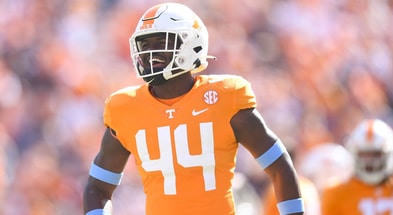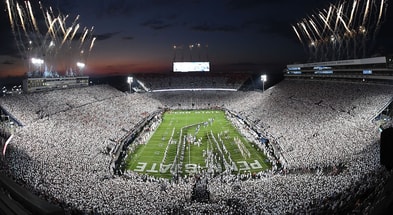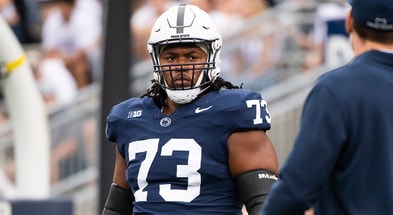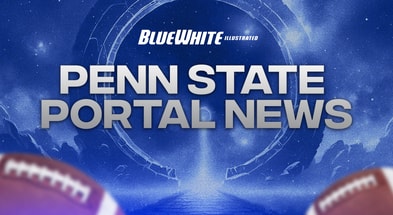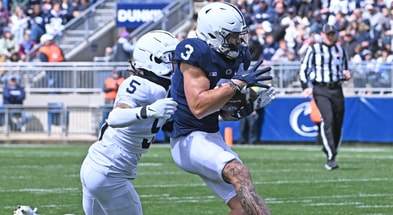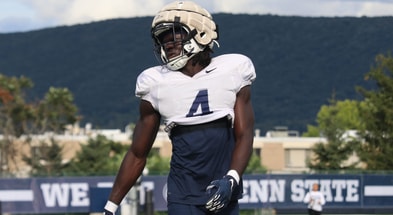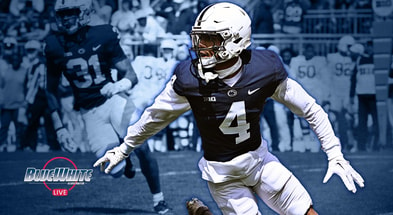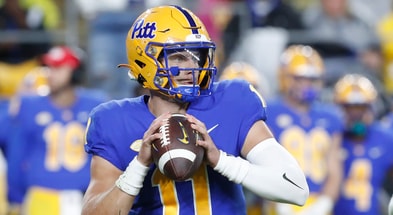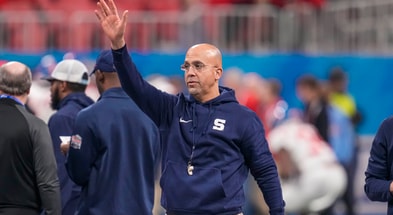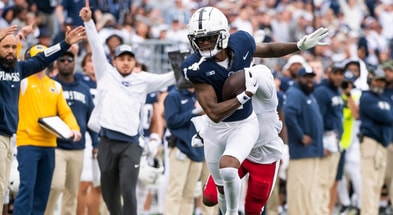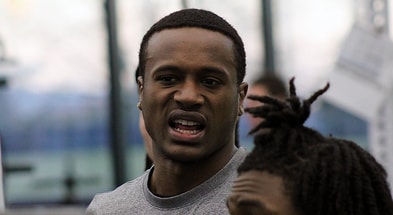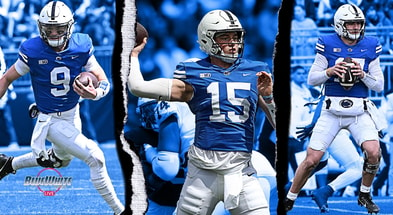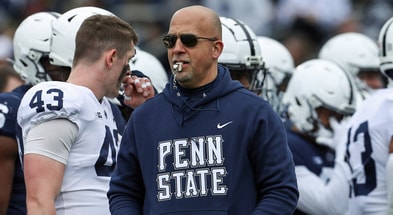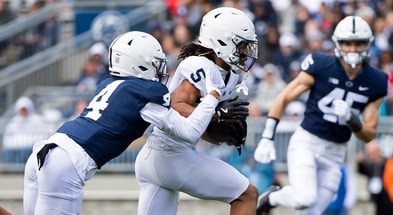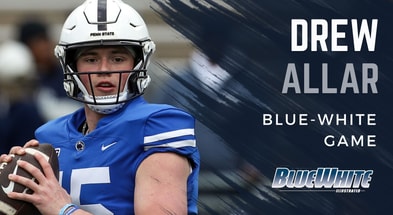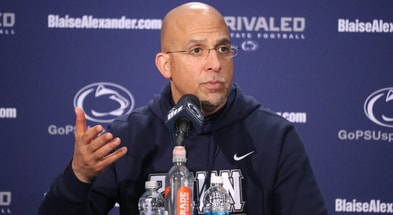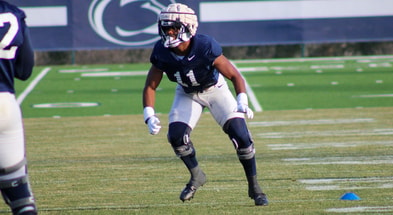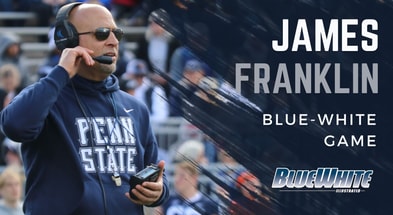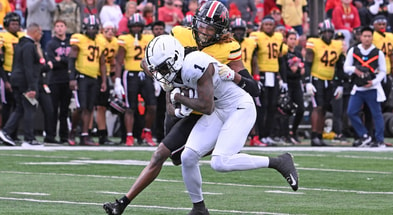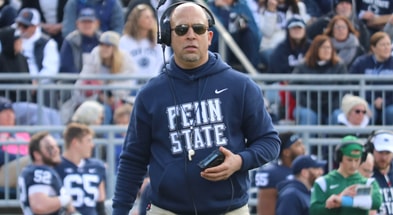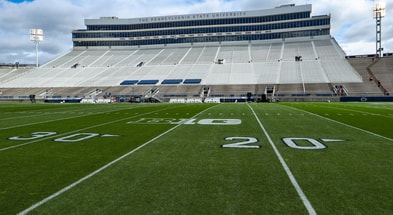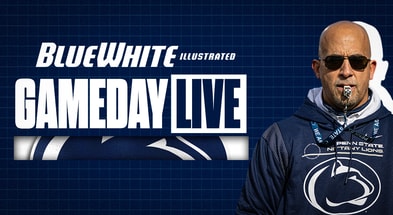Franklin speaks to Penn State NIL challenges, future alignment aims
Nearing one year since the rollout of its STATEment program, Penn State Athletics’ initial approach to name, image, and likeness rules focused on education and entrepreneurship for its student-athletes.
In a recent one-on-one interview with head coach James Franklin tackling NIL and Penn State football, he left no room for misinterpretation on the subject. Discussing the host of issues that have come to define major college football’s present and future, Franklin sized up those initial decisions, where it has put Penn State football today, and how the program moves forward from here.
Against its national peers in the NIL space, he said, Penn State football has been playing from behind.
“The challenge is, when these rules were put in place, there were no real conversations. And we took a very different model and approach,” Franklin said. “There was a committee formed (in Penn State Athletics) and there was nobody from football on the committee. So, we have the ability to take an approach and a belief that we think is in Penn State’s best interests. We took that approach. But it doesn’t align with what the market is and with what we’re competing against.
“I’m not saying it’s right or wrong. Our approach was to teach the student-athletes how to be entrepreneurs. But anybody that works specifically in football knew what was coming. And for two years, we took an approach – I’m not saying it was wrong, but it’s very different than the model that people are working with now and what we’re competing against. So now we’re spending all our time trying to catch up because we took a different approach from a model perspective.”
Though varying slightly, the current NIL model of Penn State football’s competitors is centered on two realities.
The first is that of a budding marketplace for current student-athletes to cash in on endorsement deals and other business opportunities that were previously unavailable to them. With the aid of NCAA-approved collectives and directives, the booster-backed slush funds are setting a baseline for NIL compensation to players, with or without actual work attached.
Maybe more important, the second reality is how those deals are impacting the recruiting ecosystem. That includes the transfer portal, which works hand-in-hand with the newfound freedoms of NIL rules being enjoyed by current college football players.
While the NCAA guidelines on NIL insist it cannot be used as an enticement during the process, the rules are being easily sidestepped within an organization with no apparent teeth for enforcement. Even following the letter of the organization’s current rules on the matter, and that of legislation, the ability to point to real-world examples of NIL successes within the program serves the same purpose.
Though three unaffiliated collectives make up Penn State’s NIL landscape, those being Happy Valley Talent, Success with Honor, and Nittany Commonwealth, the overall infrastructure is not as developed or robust as national competitors. But, it is not for a lack of warning.
Stressing that the current NIL environment in college football and its impact were understood long before the new rules and legislation went into effect, Franklin insisted that no one within the game can claim to be surprised by the form NIL and the transfer portal have taken.
“(The AFCA board) predicted all of this. They predicted all these things were coming,” Franklin said. “The football coaches or athletic directors that you see that are ahead of this, or conferences that are ahead of this, they knew it as well. And again, all it really takes is to sit down and have a legitimate conversation about these things. ‘OK, here are the changes that have been made and where it’s going to lead to.’”
With the impact of NIL in full effect but still constantly evolving, Penn State football’s pursuit of an aggressive, competitive approach hasn’t diminished.
Just the opposite, in fact, as Franklin and other program representatives have become increasingly outspoken in publicly addressing the topic. Most notably taking a two-pronged approach in a spring radio appearance, senior support staff stressed to fans the need for a full embrace of Penn State’s collectives while simultaneously framing the issue as an opportunity to demonstrate and harness the strength of the Nittany Lions’ broad-based community. Within that context, enthusiasm for NIL would directly correlate to future success, saying “where we go from here is going to determine our course.”
In the time since, two major changes to the university hierarchy have also impacted the future Franklin envisions.
Welcoming Dr. Neeli Bendapudi as the new university president, with Pat Kraft set to become the next athletic director beginning July 1, Franklin maintained that the crucial element to winning is alignment throughout the institution. In a competitive college football environment that demands daily decisions both significant and not, from every level of the university’s stakeholders, Franklin said he has been quite encouraged by his initial interactions with the institution’s new leadership.
“Dr. Bendapudi has been phenomenal. Her energy has been awesome,” Franklin said, praising her chief of staff, Michael Wade Smith, and his hands-on, involved approach. “I think that’s important because obviously, you don’t really want to be going to the president for everything. They got enough things on their plate. So this helps with that, not just in athletics, and not just in football, but in all these different areas. I think that’s valuable.”
Meanwhile, Franklin added that his dialogue with Kraft has been near-constant. Recalling one particularly early, 5:15 a.m., 45-minute conversation with Kraft while in Arizona this spring, Franklin said the frequent back-and-forth has been beneficial.
“I would rather that. I’d rather have the conversations early in the morning, late at night, so that I can hear his perspective, he can hear mine,” Franklin said. “Ultimately, he’s the athletic director. He’s got to make the best decisions. But having those conversations allows me to understand what direction he’s going and why, and also for him to hear from me. I think that’s really important, and it’s been good.”
Vowing that Penn State football will continue to compete in every facet of college football’s new landscape, the initial tack for NIL is one Franklin is committed to seeing make improvements. Acknowledging its role now as a foundational element of roster management, the next steps, like those before it, are critical.
But in setting out to foster an environment in which current trends are balanced against an understanding of what’s coming, Franklin said both will be important not only to Penn State but also to the Big Ten as it moves forward.
“Some athletic departments and some universities and some football programs understood that, sat down, had really good dialogue, and were prepared for when it came. And others were not. That is, to me, the sense of urgency,” he said. “You make a couple of decisions that put you in a disadvantageous position, and that can have dramatic impacts on your season.”
Just as true to the positive, it’s an opportunity for aggressive decision-making that Franklin is eager to see in action moving forward.
